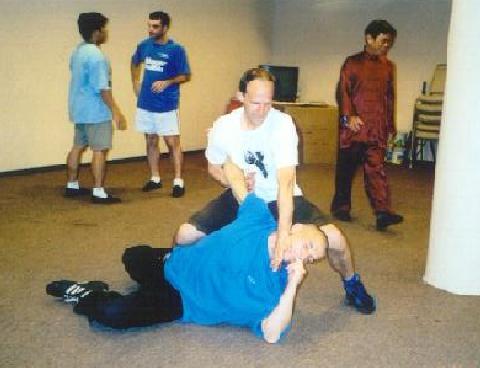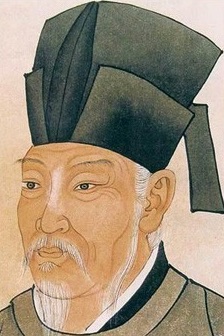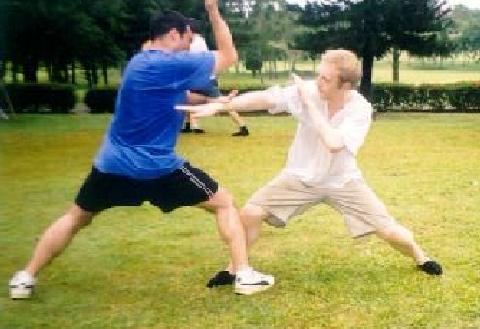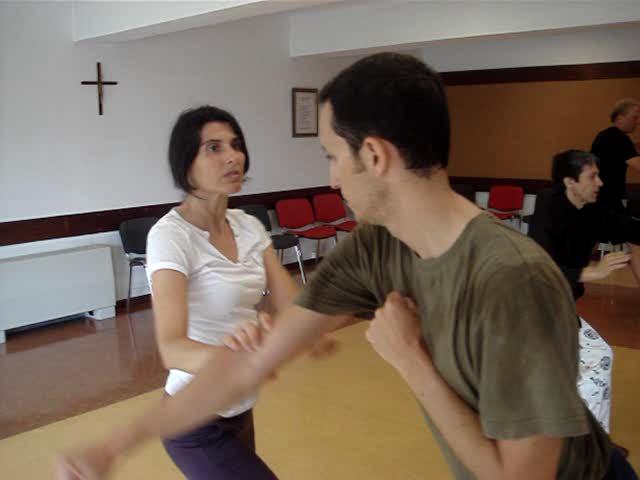July 2003 (Part 3)
SELECTION OF QUESTIONS AND ANSWERS

During a sparring session at a Special Shaolin Kungfu Course in Malaysia in May 2003, Sifu Kai Uwe Jettkandt, a grandmaster of Jujutsu and an international all-style sparring champion, applied the Shaolin pattern “White Monkey Catches Pig” on Ronan Sexton. In a real fight, Sifu Jettkandt would have broken the opponent's right arm and torn his throat with a Tiger Claw. In the background Chun Nga and Euguene discussed a point about their sparring, while Sifu Wong walked towards some students (hidden behind the pillar).
Question 1
I have been interested in Buddhist beliefs for a number of years now. I am originally Church of England by birth, but have always found that Buddhist principles make more sense to me.
— James, England
Answer
A famous Chinese poet (Pai Chu Yi, if I am not mistaken) once asked a great Zen monk (Shi Tou, if I remember correctly) what the gist of Buddhism was.
“Avoid all evil, and do good”, the monk replied.
“Even a three-year old child knows this,” retorted the poet.
“A three-year old may know, but a eighty-year old may not practice it,” the great monk said.
Actually the gist of Buddhism as summed up by the Buddha himself is
- Avoid all evil
- Do good
- Cultivate the mind
Zen masters were well known for giving just the right teaching at the right time. There must be some good reasons why the great Zen monk mentioned only the first two points to the poet. I would guess that had the monk mentioned “Cultivate the mind”, it might confuse the poet at that time.
There are many ways to cultivate the mind. Just closing your eyes and thinking of nothing is one way. Reciting any scripture wholeheartedly is another. Practicing genuine chi kung or kungfu a third way. But putting information into your brain, which may be beneficial by itself, is not cultivating your mind.
One needs not forego his own religion to practice and benefit from Buddhism. In fact when one become pious in his religious practice, he becomes a Buddhist usually without his conscious knowing.
Question 2
Recently, I saw the Shaolin soldier-monks in London. I love the idea of a combined martial art that focuses on happiness and well-being instead of violence. I have been trying to find a centre in London, with respected teachers. I am worried that I will end up being taught just for show, and my interests lie in improving my state of mind, reducing stress, internal happiness and general good health with the combined physical health from learning Shaolin Kung Fu. Ideally, I would like to find somewhere that teaches all aspects, i.e. chi kung and Zen as well.
Answer
Some modern Shaolin monks have established a United Kingdom Shaolin Temple in London. I do not know the address but you can find out from your local telephone company or search the internet.
But I am not sure whether what they teach at the London Shaolin Temple is what you are looking for, i.e. a martial art that also improves your mental state, reduces stress, and promotes internal happiness and general good health. It is best that you personally find out for yourself.
We also have our Shaolin Wahnam centres in London, which is headed by Sifu Dan Hartwright, who is one of my disciples appointed by me to teach our Shaolin arts. His contact particulars are as follows: telephone/fax +44 1903 536340, e-mail dan@wahnam.com, and website http://www.wahnam.com/uk/.
In all our Shaolin Wahnam centers, including the one in London, we aspire to teach not just a martial art or chi kung but also all the benefits you have mentioned as well as other worthy qualities symbolized by the scholar-warrior ideal, such as mental clarity, intellectual depth, courage and righteousness. Again, it is best that you find out for yourself how well, or badly, we succeed in fulfilling our aspirations in our teaching.

Bai Ju Yi, a Chinese poet of the Tang Dynasty, Picture reproduced from http://genius.com/Bai-juyi-a-visit-to-qiantang-lake-in-spring-annotated
Question 3
London life can be especially stressful and I think this would be a great way of learning to relax my mind as well as stay physically healthy.
Answer
Stress is a major problem facing our world today, especially in big cities like London. Staying healthy is another major problem, even among those who live in the countryside.
Yet, to be relaxed and healthy is actually simple, although it may be difficult for most people today. It is not a contradiction, it is a paradox. The crucial factor is that to be simple is not necessarily the same as to be easy.
Relaxation and health are natural. This means if all the parts of your body (and mind) — cells, glands, organs, systems, etc — work naturally, you will be relaxed and healthy. You become tensed or sick when one or more of your body parts work out of order. The fundamental task of chi kung is to restore the natural working of your body. In chi kung jargon, it is called restoring harmonious energy flow.
Moreover, we aim for a “vertical shift” rather than a “horizontal shift”. In other words, by improving your skills you can be relaxed and healthy in London or any places in the whole world. You don't have to change your working habits or place of residence. Your shift to relaxation and health is by moving upward in living skills, and not by moving horizontally away from your daily work and play.
In our Shaolin Wahnam philosophy, while we are aware that being relaxed and healthy is the immediate objective of many of our students in learning from us, we are more ambitious in our aims. All the arts we teach — Shaolin Kungfu, Wahnam Taijiquan and chi kung — are vehicles for physical, emotional, mental and spiritual development. Being relaxed and healthy is just our starting point. We are very clear about our vision and direction. Should we fail to achieve our aims and objectives, it is not because we did not know what we wanted and how to get it, but because of other factors, such as incompetent teaching or insufficient practice.
Question 4
I am currently reading 'The Art of Shaolin Kung Fu” and have decided to ask you for your advice on training possibilities in London. In the future, I would love to come to Malaysia for a course, but I would like a good level of experience before I do that.
Answer
“The Art of Shaolin Kung Fu” provides a sound understanding of the scope and depth of Shaolin Kungfu. Among many other things, it will enable you to choose a good school or a good teacher, and to practice well so that you may obtain maximum benefits in minimum time.
For example, understanding the four dimensions of kungfu explained in the book, you would realize that merely learning kungfu forms — no matter for how long you may learn and how beautifully you may perform the kungfu forms — you would at best obtain only a portion of what kungfu can offer.
My other two books, “The Complete Book of Tai Chi Chuan” and “The Art of Chi Kung”, do the same things for Taijiquan and chi kung.
I would advise that you attend the Shaolin Kungfu classes taught by Sifu Dan Hartwright in London. But to be fair to yourself, you should also spend some time looking at other kungfu schools in your area before making a decision.
You are welcome to attend my Intensive Shaolin Kungfu Course in Malaysia. It is wise to have some foundation before attending my course so that you can spend your time with me on developing internal force and combat application instead of learning kungfu forms.

Combat application is an essential aspect in traditional kungfu training. Eugene brushed aside an opponent's palm thrust and was about to chop at the opponent's head or arm with his right hand..
Question 5
I'd just like to say that your website is a really good one. There are so many websites out there that don't seem to want to share information. You actually show how Tai Chi and other kung fu styles can be used in practical manners. A friend of mine who was learning Tai Chi was just telling me the other day that his master said that Tai Chi would not be effective against a street attack. Thanks to your website I now know otherwise.
— Justin, Malaysia
Answer
Thank you for your kind words.
It is understandable if other masters may not want to share their knowledge. That is actually the norm. In this respect, I am quite like a freak. It is quite true that I am sharing knowledge that many masters in the past might not even tell their daughters.
The internet is an amazing invention. Never before in history can we share so much information so readily. But there is also some setbacks. There are also websites that give wrong or harmful information, and there are discussion groups where persons with little or no chi kung or kungfu experience at all, give advice on these topics as if they were experts.
Taijiquan is a wonderful martial art, but it has degraded so badly that in most cases it has become a dance. An ironical, perhaps inevitable, development in organized Taijiquan and other styles of kungfu as well as in chi kung is that today these instructors who teach a much degraded forms of the arts are in control of most national and international federations of these arts. This is so because they are the majority in the membership of these federations. If any public or governmental bodies wish to obtain information of these arts, they will most likely consult these federations.
Question 6
It's so true that people who learn kung fu tend to fight like children in a haphazard way using very little of what they've practiced. I hope that I will be able to achieve the level where I'd be able to fight using kung fu and not some borrowed moves.
Answer
Kungfu practitioners fighting like children is now the norm, and has become a laughing stock among martial artists of other systems. The main fault is that the methodology to teach kungfu practitioners progress from solo form practice to free sparring is now generally lost.
Some masters attempted to overcome this shameful situation. Their main approach was to borrow training methods from other martial arts, particularly from Karate and Taekwondo. Some did very well and their students became good fighters. An outstanding example was Bruce Lee. But the fact remained that they did not employ typical kungfu forms for fighting.
Today a serious problem is emerging. Some world known Shaolin and Taijiquan masters even go to the extent of publicly saying that traditional kungfu forms cannot be used for fighting! What they use and teach for combat is Boxing, Kickboxing, Karate, Taekwondo or freestyle fighting. You may find their views and pictures in their official websites. Traditional kungfu forms, they insist, are meant only for teaching certain combat principles or for strengthening the practitioners' legs.
This is shocking. It is also a great insult to generations of masters in their own lineages who had demonstrated in texts and pictures that the traditional kungfu forms the masters taught were combat efficient.
Against such a varied background, my website, books and the intensive courses I offer the public are a sincere attempt to check the fast deterioration of kungfu and chi kung. My effort is only a ripple in an ocean but at least the wonderful arts that my masters so kindly and generously transmitted to me, can be passed down to some deserving disciples.

Taijiquan is a wonderful martial art; it is not a dance
Question 7
I am an American college student and have been training in different forms of martial arts for several years, primarily Aikido. Within the last couple of years I have developed the dream of wanting to train intensively in martial arts for an extended period of time. I plan to move to the East where I want to study the culture and learn Mandarin Chinese. I would also like to train intensively in Shaolin Kungfu. Do you accept any Western students, despite their lack of experience?
— Phillip, USA
Answer
Attending my Intensive Shaolin Kungfu Course in Malaysia will be a good choice to fulfill your aspirations. There are three main conditions for attending my Intensive Shaolin Kungfu Course.
The first and most important condition is to follow and practice the Ten Shaolin Laws in your daily life. If you look at the tenth law, you will understand that I accept students of all cultures, races and religions. Indeed, because of my frequent travels in the West in the past few years and the great number of Westerners attending my courses in Malaysia, now I probably have more Western students, including some of my best students, than Chinese ones.
The second condition is to work hard — before, during and after the course. I would emphasize that my Intensive Shaolin Kungfu Course is very tough. You would have to train internal force, which can be very demanding, and combat application for a few hours every day. But hard work is not necessarily toil and pain, which we affectionately call the water-buffalo methods. We believe in using smart methods, which often bring subtle joys.
The third condition is to have some prior experience in Shaolin Kungfu. Ideally you should have learnt Shaolin Kungfu from our Shaolin Wahnam instructors in various parts of the world. But it is all right if you have learnt any style of kungfu, even merely external kungfu forms, or any other martial arts so long as you can perform basic Shaolin stances and patterns reasonably well. You can check up on these basic stances and patterns in my Shaolin books.
It is also advisable for you to strengthen your arms so that they are reasonably fit for sparring a few hours a day during the course. An excellent method is “Golden Bridge”, which you can read from my books. If this is not possible, an alternative way is to condition your arms by striking them against a pole or a tree. This is an example of what we call a water-buffalo method, but it serves your purpose well, and you can also compare it to smart methods we prefer during the course. After striking your arms against a pole or a tree, you should perform “Lifting the Sky” or apply medicated wine or bathe your arms with warm water to clear possible energy blockage and blood clot.
After attending my Intensive Shaolin Kungfu Course you will have to practice on your own. It would be a good opportunity for you to join other kungfu schools in Malaysia on a regular-class basis. Staying in Malaysia is safe, comfortable and cheap by American standards, and the fees you pay to the other schools will be much, much less than what you pay for my Intensive Course. Due to historical and geographical factors, Malaysia is particular rich in kungfu masters teaching a great variety of styles. You can also learn many classical weapon sets from them. You will also find that the Intensive Course you have learnt from me give you a big advantage over your classmates, including your seniors.
Personally I find Malaysia a better place than even China or any other places in the world to learn Chinese languages and culture! And the best Chinese food is found in Malaysia — an opinion shared by many participants to my intensive courses who also have been to China and other countries with large Chinese communities. Incidentally, this is a tribute to the Malaysian government, showing how free and democratic Malaysia is.
If you wish to learn Chinese in China, you will probably learn only Mandarin or just one local dialect if you stay in outlying areas. In Malaysia within a typical town, like Penang, you can learn Mandarin, Cantonese (a very important language in kungfu), Fujianese (the native dialect of Taiwan), Teochiew and Hakka. If you wish to witness traditional Chinese festivals, like Chinese New Year celebrations, or Chinese religious rituals, like walking over fire in Taoist celebrations, you don't find them in modern China, but you can find them in Malaysia.
Question 8
I can't thank you enough for the special Shaolin Kungfu Course. It was a fantastic learning experience as always. It has given me a much better understanding of Shaolin Kungfu and I feel like I'm getting a lot more from my training now.
— Ronan, England
Answer
I am very pleased with the course too, and you have done well. Having achieved what you did after two years of training in Shaolin Wahnam, including being able to fight effectively using typical Shaolin patterns, and enhancing your daily life and work with internal force, many other people might think they had reached the apex of their training, and there was nothing more kungfu could offer them.
Hence, your comment that now you have a better understanding of Shaolin Kungfu and that you are getting more from your training, indicates you realize actually now you have just begun your long journey of Shaolin training and there are many more wonderful benefits ahead.
The recent Special Shaolin Kungfu Course will be a landmark in our Shaolin Wahnam history. Among many other things, it will lay the foundation for our scholar-warrior project, ensuring that our Shaolin Wahnam instructors will teach not just Shaolin Kungfu, Wahnam Taijiquan or chi kung, but a comprehensive programme for physical, emotional, mental and spiritual development for the enrichment of self and others.
Question 9
Chun Nga was explaining to me the training methods for Iron Palm and I have also read them from “The Complete Book of Shaolin”. With your permission I would very much like to start training for “Iron Palm”.
Answer
You already have the basics of Cosmos Palm, and are able to break the bottom brick of two bricks without breaking the one on top. Training for Iron Palm now is like going from first class kungfu to third class kungfu. However, the fault is not your intention but your use of terms. What you mean is to train for Vajra Palm, or Diamond Palm.
“Diamond” is not an exact translation for “Vajra”, but is the closest in a Western language. The full term in Chinese for this art is “Siu Lam Tai Lek Kam Kong Cheong” (Cantonese pronunciation), which means “Shaolin Great Force Vajra Palm”. In Mandarin it is pronunced as “Shao Lin Da Li Jin Gang Zhang”.
The Vajra Palm is even harder and more powerful than Iron Palm, yet the hands of the practitioner are soft and smooth like those of a Cosmos Palm practitioner. Vajra Palm or Diamond Palm is like a combination of Cosmos Palm and Iron Palm. It is a much higher level art than Iron Palm, and is about the same level as Cosmos Palm. I shall explain the training methods to you later. Meanwhile, continue with your energy and mind training.
Although Chun Nga knows the training methods for Iron Palm, what he has trained is also not Iron Palm. His palm strikes are powerful but his palms are soft and smooth. It may be of interest to recall that he could break a brick when he was only eleven years old, at an age too tender to break a brick with muscular strength. The remarkable fact was that at that time he did not learn chi kung from me directly. He observed his senior classmates learning from me, then asked them to teach him.
